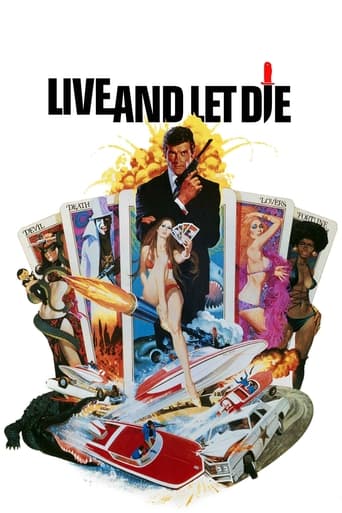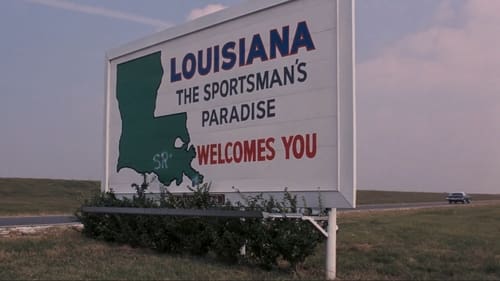



Wow! Such a good movie.
This is How Movies Should Be Made
Highly Overrated But Still Good
If you're interested in the topic at hand, you should just watch it and judge yourself because the reviews have gone very biased by people that didn't even watch it and just hate (or love) the creator. I liked it, it was well written, narrated, and directed and it was about a topic that interests me.
View More"Live and Let Die" is one of the more deceiving "James Bond" films. The face of the franchise may have changed with Roger Moore assuming the mantle of 007, but everything below the neck is fairly familiar. So what seems like a reboot is more like a facelift, albeit a needed one.Moore comes to the role of Bond with an energy that Connery clearly lacked by the end of his tenure, despite Moore being in his forties (and three years older than Connery period) when beginning what would become a seven-film run. He definitely feels like an "elder statesman" Bond, with his charm and cunning his greatest assets. Nevertheless, he seems excited to slide into the familiar "Bond" scenarios and dialogue and make them his own.These "Bond" elements are familiar because of the return of "Diamonds are Forever" writer Tom Mankiewicz and director Guy Hamilton. That film was a disaster in many respects, so the fact that "Live and Let Die" is an improvement is no small feat. (Then again, Hamilton did helm "Goldfinger," so who knows?) Like "Diamonds," the story keeps Bond predominantly on American soil after a few British agents are compromised in New York City, New Orleans and the fictional island of San Monique. The connection between them all is the superstitious crime syndicate leader and heroine kingpin Dr. Kananga (Yaphet Kotto) and his lackeys Tee Hee (Julius Harris), Baron Samedi (Geoffrey Holder) and tarot card reader Solitaire (Jane Seymour).The film's release during the era of Blaxploitation films in cinema makes the black villain and various other black characters particularly interesting to say the absolute least. On the one hand, the film features black actors in key roles in an action franchise that in many ways couldn't be whiter. On the other, almost all the black characters are sinister, and Bond heads off into the sunset with the doe-eyed fair-skinned British lady who is clearly out of place, even if she's engaging to watch. At least Bond doesn't go blackface, i.e. this film avoids the social misfire of "You Only Live Twice."Regardless of how the black cultural and voodoo cultural elements were handled, they certainly make "Live and Let Die" a more memorable "Bond." The jazz funeral/second line sequences are unforgettably brilliant, the night club trick tables are pretty clever too and Bond's crocodile escape is surprisingly harrowing given the legitimate stuntwork. And while Q may be absent, the magnet watch features prominently and creatively throughout the film. These touches are truly what make "Bond" films memorable and fun and there's more hits than misses, unlike Mankiewicz's work on "Diamonds.""Live and Let Die" is probably a masterpiece compared to "Diamonds," but objectively, it's merely a good "Bond" entry and a necessary course-correction. The film relies way too much on formula, with predictable chase sequences involving unusual vehicles and a last-second plot to kill James in the epilogue, to name examples. "LALD" has Bond operating a propeller plane, double-decker bus and a speedboat (one of the lengthiest and most tiresome "Bond" chases with barely enough payoff). Hamilton continues his preferred style of filming all these sequences with slapstick in mind rather than making them feel dangerous or suspenseful. Then there's the film's J.W. Pepper problem — the unnecessary caricature of a Louisiana sheriff is worth knocking the whole film down a peg.Anchoring "Live and Let Die" is Paul and Linda McCartney's title track, which one-off "Bond" composer George Martin wisely builds into the film's score at some needed moments. A mostly uptempo rock song, it's uniqueness helps accent the many ways in which "Live and Let Die" stands out among the "Bond" canon, in spite the many ways it still heeds to formula and shares qualities with some of its lesser "Bond" peers.~Steven CThanks for reading! Visit Movie Muse Reviews for more
View MoreThe great and cool Roger Moore has left us and to pay homage, french TV changed programs to offer his 1st appearance as 007 ... and that one was indeed among his 2 007 movies i haven't seen so far (the last one is now Mooraker !). But honestly this one offers a really poor story for a 007 movie ! If the spy is expected to go in exotic locations, here, 007 goes to US ! Not really incredible ! Next, if he is the last hope against world threat, here, he deals with coke traffic ! The action sequences are pretty boring : the bus, then the boat, the crocodiles then the sharks The only value of this movie is the franchise trademark that is to say its ability to vacuum and recycle trends: in other words, all 007 movies are deeply shaped by the time of production and as this one has more than 40 years, it has a great historical value: first, the narcotic traffic had just started in the movies: from my history, the oldest one about it is Pacino's Needle Park in 1971.. And for sure, the movie is just mesmerized by the blaxploitation era : all characters are blacks and we have all their classic items : music, car, Harlem, jewelry, fashion and also a very charming tiny sidekick At the end, it's not Moore's best but it's no its worst (for your eyes only )
View MoreOverproduced, but Daring, this the 8th James Bond Film was the First to Introduce Roger Moore as 007. He was 45 Years Old and would Continue in the Longest Running Franchise in Film History for over a Decade.Coming in the Age of the Newly Arriving "Blaxploitation" Genre/Craze ("Shaft" was released in 1972) the Writers/Producers had No Qualms about Inserting the British Super-Spy in the Middle of Urban America and a Black Heroin Kingpin Ring.Maybe They should have had Some Qualms. Because On Screen Bond has the Appearance of an Ill Fitting Suit. Moore tries on the Role and while He is a Good Looking Secret Agent, the Smoldering Good Looks and Underlying Intelligence of Connery are Absent. At times Roger Moore's Bond seems a bit Lost or Playing it by Ear.Along with the Ill Advised Harlem Shuffle, there are other Ridiculous Inclusions like a Voodoo Virgin Princess and a Redneck Sheriff that is so Cringe Inducing it almost Stops the Film Cold.The "Smokey" shows up in the Longest Chase Scene Imaginable with Bond taking a Speed Boat on Land and on Water with Equal Ease. But Not Before He made a "Cartoon" Escape from an Alligator/Crocodile Farm, using a Previous Trick Utilized by "Bugs Bunny".Overall, the Catchy Title Tune by "Wings" is Memorable, as is Yaphet Kotto and Jane Seymour.The Movie isn't the Worst in the Series but it would Solidify this Money Making Formula for a Long Long Time, and the Franchise would Live and Die with a Range of Results.
View MoreThis is a truly amazing movie to watch in the year of Trump, and compare to the year it was made, 1973 so 43 years ago. I can't imagine that everyone involved had an explicit political message; rather they were just channeling the times. But damn, what times they were channeling. Every stereotype of "the other" you can imagine is here, and proudly displayed. Black men do, in fact, form a single organized cabal. They are intent on poisoning "us" all. They want to steal and deflower "our" women. They believe in strange savage cults and engage in ghastly rituals. Hell, in the last mass ritual scene I half expected the boiling pot to come out and a cannibalism trope to join everything else we'd seen so far. It's a weird weird mix --- think James Bond meets the Protocols of the Elders of Zion, with the word Jew find-and-replaced with Black. You have to see it to believe it.Oh, and of course the usual Bond formula is well established by now. We have the gadgets, the multiple different types of chases and fights, the underground lair, the stupid evil genius who cannot shut up about his evil plans and never just shoots his enemy the moment he see him. We even have the first prototype of that canonical Roger Moore James Bond villain, Jaws!If you're going to see just one early Bond movie, make it this one; if for no other reason than to see how much has changed (and how much hasn't) over forty+ years.
View More